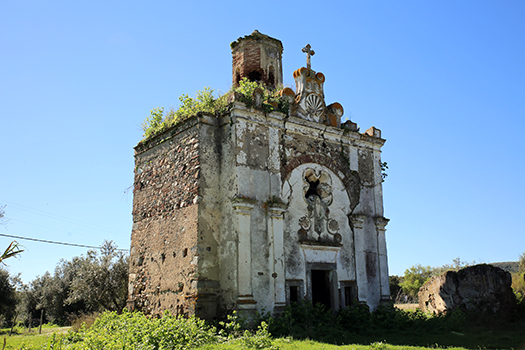 |
The hermitage is located about 200 meters southeast of the Sanctuary of Nossa Senhora de Aires (Our Lady of Aires).
Although the devotion to Christ is very old, the great Christological outbreak in Portugal occurred in the 17th and 18th centuries, a time when popular devotion to the Crucifix increased the number of small chapels and large shrines dedicated to Jesus, located outside the villages. Along with this devotion, the Marian cult and the construction of shrines that give expression to it also developed at the same time, such as is the case with the present sanctuary of Nossa Senhora de Aires, resultant from a replacement, made in the 18th century, of an early 16th century building.
The construction of the small chapel of Lord Jesus of the Cross (Senhor Jesus do Cruzeiro) of Viana is also, precisely, a manifestation of the popular devotion to the Crucifix in the 17th century. Therefore its plan is in Greek cross.
According to documental information of that time, the hermitage’s construction was determined in 1742, to be executed in the site of a pre-existing calvary, that is, where there already existed a "cross of Senhor Jesus da Pedra” (Lord Jesus of Stone)". This cross would be, according to Espanca, the castle’s calvary, that would have been transferred to the interior of the walled enclosure already around 1804.
We know that, by deed of 15th November 1742, Geraldo da Silva Rocha, a resident of Ferreira, who owned a land for pasture with vineyards and orchards on the site of the calvary, protected lands of the village where hunting was forbidden, donated, in that same pasture land, close to the cross of Senhora da Pedra, a piece of land for the church’s construction. It was forty-six spans long and twenty-three spans wide. It was further determined, in the same act, that the church door would be facing the road to Nossa Senhora de Aires.
In the same document Brother Manuel Frutuoso is quoted as saying that, out of devotion, he asked for the works of the church of Senhor Jesus da Pedra. He would probably be a member of some brotherhood or group of believers who, more informally, venerated the mentioned cross.
In 1755 the hermitage do Cruzeiro - for representing Christ on the Cross - was already built. In it was an inscription indicating that it was financed with alms from the faithful and the first mass was celebrated there on 26th September 1756.
Raquel Seixas considers that, just as it happened elsewhere, the Chapel of Senhor Jesus do Cruzeiro may follow a logic of fusion between the Marian cult and the cult centred in Christ. First of all, it is affirmed in the iconography of Nossa Senhora de Aires that it is, in fact, a representation of Nossa Senhora da Piedade (Our Lady of Piety) , i.e., the figure of the Lady as a witness of the crucifixion of Christ, who is represented on her lap. As such, the chapel of Senhor Jesus do Cruzeiro, representative of the last steps of the Passion of Christ, was added to the shrine of Senhora de Aires’ surroundings. According to the author's words, "These two temples together tell the same story, thus complementing one another. After the Crucified Christ comes the Lady of Aires (of Piety) who together with her Son suffered before the Cross."
Because of the period of construction, the chapel is of Baroque style, with a Greek cross plan with little protruding arms, practically quadrangular, covered with a hemispherical dome. The vault, resting on squinches, has an octagonal roof lantern meant to provide more illumination to the interior, and is crowned on the outside by a spire.
The portal is framed by two identical square windows and above it opens a clover-shaped window. The façade is topped by a small pediment, decorated with a scallop, over which a cross of polished foils stands.
The chapel is nowadays much degraded. The interior, of unified space, was stripped of its original elements, including the main altarpiece. There are still some vestiges of mural paintings.
Protection: National Monument, Decree n.º 31-J/2012, DR, 1.ª série, n.º 252 de 31 Dezembro 2012
REFERENCES
Arquivo Distrital de Évora, Cartório Notarial de Viana do Alentejo, Lv. 31.
ESPANCA, Túlio, “Estudos Alentejanos”, A Cidade de Évora: Boletim de Cultura da Câmara Municipal (1ª Série), nº 60, 1977, pp. 189-284.
PÁSCOA, Marta Cristina, Fr. Francisco de Oliveira – a escrita da História Regional e Local no século XVIII, vol. II, Lisboa, Faculdade de Letras da Universidade de Lisboa, 2002 (Tese de Mestrado policopiada)
SEIXAS, Raquel, O Santuário de Nossa de Aires: arquitectura e devoção (1743-1792), Lisboa, Universidade Nova, 2013 (Tese de Mestrado policopiada).
http://www.monumentos.pt
http://www.patrimoniocultural.pt

 Abrir Lista
Abrir Lista MUNICÍPIO DE VIANA DO ALENTEJO
MUNICÍPIO DE VIANA DO ALENTEJO